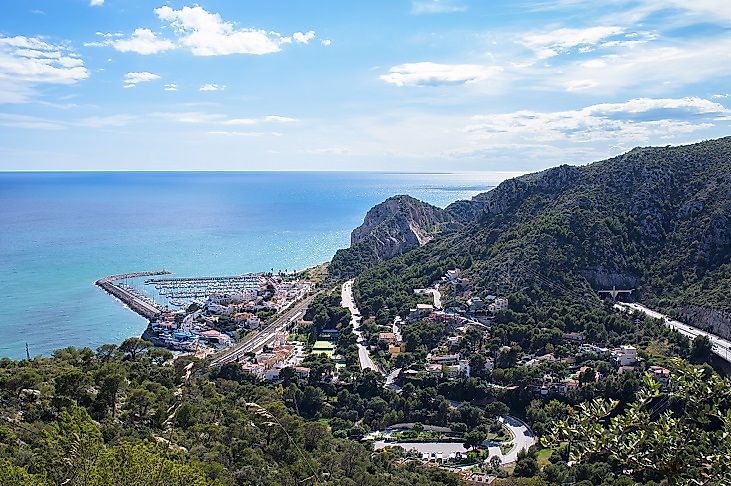Ecological Regions Of Spain

The Kingdom of Spain is located on the Iberian Peninsula in the southwestern region of Europe, with several small territories along the North African coast and in the Atlantic Ocean. Spain’s mainland is bordered by Mediterranean Sea, France, Andorra, Portugal, and the Atlantic Ocean. Spain is the world’s 52nd largest country with a total area of 505,992 square kilometers, including islands such as Balearic and Canary Islands in Mediterranean and Atlantic Oceans respectively. The mainland is mountainous, dominated by mountain chains and high plateau. Spain has three climatic zones, with Mediterranean, Semi-Arid, and Oceanic climates, respectively. The country is further divided into several ecological zones, some of the most notable of which are looked at below.
Iberian Conifer Forests
Spain's Iberian Conifer Forests cover parts of several mountain ranges in the country, including the Gudar, Cazorla, Baza, Sierra Nevada, and Javalambre ranges. The ecoregion is characterized high annual rainfall of between 1,100 millimeters and 1,500 millimeters, accompanied by snow fall during winter. The temperature range is between -50 Celsius and 00 Celsius. Due to the high altitude of this ecoregion, the forest zones are divided into a conifer zone and a mixed broadleaf zone. Endemic Salzmann pine, Scotch pine, and Maritime pine dominate the canopy tree species of the conifer forest. Iberian Conifer Forests host diverse species of fauna including more than 150 species of birds, several endangered mammals such as the Gredos ibex and wolf, amphibians and reptile species. Road and railway construction and ski facilities are major threats to this ecoregion.
Iberian Sclerophyllous and Semi-Deciduous Forests
The Iberian Sclerophyllous and Semi-Deciduous Forests cover mainly the valleys, plateaus, and low plains of the Iberian Peninsula. The ecoregion experiences hot and dry summer, and mild and sub-humid winter with the northern plateau experiencing continental climate. The annual temperature for this region ranges from 10 Celsius to 150 Celsius and an annual rainfall of between 300 millimeters to 850 millimeters. The forest ecosystems are conifer canopy and broadleaf evergreen species. The rivers within the ecoregion contain species of endemic fish Anaecypris hispanica and are also a refuge for some mammals. The region hosts 220 species of vertebrates including birds and reptiles. Iberian Sclerophyllous and Semi-Deciduous Forests have been transformed into agricultural land for crops including wheat and olives. Intensive irrigation and greenhouse crops are the major threat to the ecosystem.
Northeastern Spain and Southern France Mediterranean Forests
The Northeastern Spain and Southern France Mediterranean Forests cover parts of Southern France and the Valencia and Catalonia regions in Spain. Mesozoic and Quaternary sedimentary rocks dominate the ecoregion. The forests within this ecoregion are composed of mixed evergreen and deciduous broadleaf and conifer species. The average temperature ranges from 50 Celsius to 170 Celsius with an annual precipitation of 350 millimeters to 850 millimeters. The ecoregion hosts 1,450 species of plants of which 180 species are endemic while large mammals are very rare in this region. There are also 30,000 pairs of birds and several species of reptiles and amphibians in within this ecosystem. Northeastern Spain and Southern France Mediterranean Forests has suffered the effects of agriculture with large portions transformed to agricultural land. House construction, the building of quarries, and an increase in water consumption are also some of the threats to this ecoregion.
Human Disruptions to the Biomes of Spain
The ecological regions of Spain are divided into four biomes, namely including marine, freshwater, Temperate Broadleaf and Mixed Forests, and Mediterranean Forests, Woodlands, and Scrub. Most of the ecoregions have been affected by the expansion of agriculture with most of the areas turned into agricultural land
Ecological Regions Of Spain
| Ecological Regions of Spain (as per World Wide Fund for Nature) | Biome |
|---|---|
| Iberian Conifer Forests | Mediterannean Forests, Woodlands, and Scrub |
| Iberian Sclerophyllous and Semi-Deciduous Forests | Mediterannean Forests, Woodlands, and Scrub |
| Northeastern Spain and Southern France Mediterranean Forests | Mediterannean Forests, Woodlands, and Scrub |
| Northwest Iberian Montane Forests | Mediterannean Forests, Woodlands, and Scrub |
| Southeastern Iberian Shrubs and Woodlands | Mediterannean Forests, Woodlands, and Scrub |
| Southwest Iberian Mediterranean Sclerophyllous and Mixed Forests | Mediterannean Forests, Woodlands, and Scrub |
| Cantabrian Mixed Forests | Temperate Broadleaf and Mixed Forests |
| Pyrenees Conifer and Mixed Forests | Temperate Broadleaf and Mixed Forests |
| Cantabric Coast and Languedoc | Freshwater |
| Eastern Iberian Rivers and Streams | Freshwater |
| Southern Iberian Rivers and Streams | Freshwater |
| Western Iberian Rivers and Streams | Freshwater |
| Alboran Sea | Marine |
| South European Atlantic | Marine |
| Western Mediterranean | Marine |











